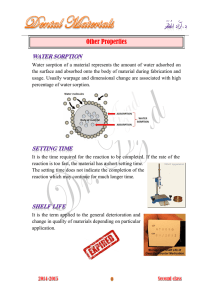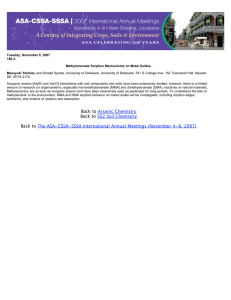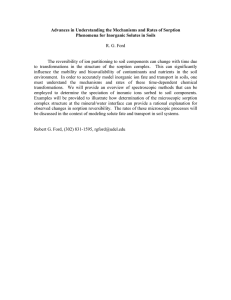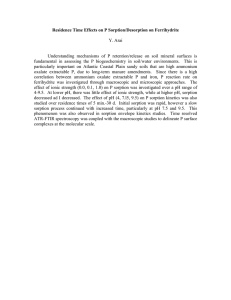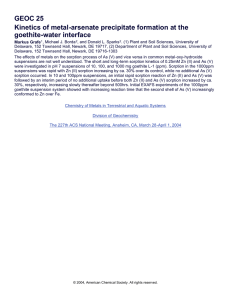Interactions between calcium phosphate and heavy metal ions in aqueous solution 5
advertisement
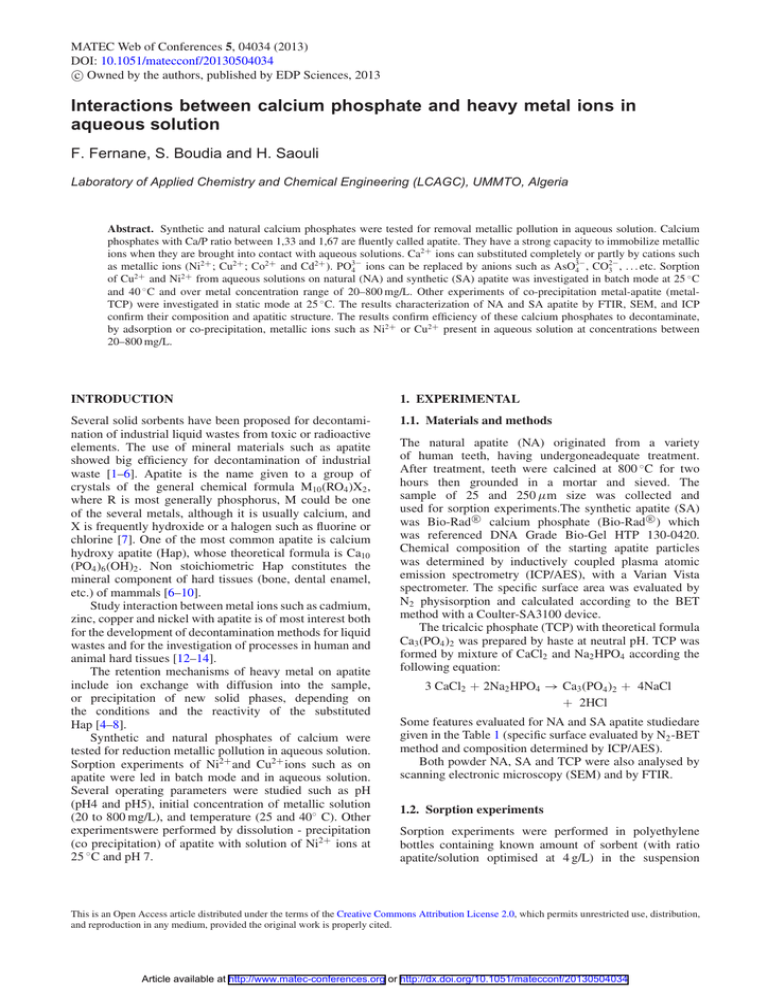
MATEC Web of Conferences 5, 04034 (2013) DOI: 10.1051/matecconf/20130504034 c Owned by the authors, published by EDP Sciences, 2013 Interactions between calcium phosphate and heavy metal ions in aqueous solution F. Fernane, S. Boudia and H. Saouli Laboratory of Applied Chemistry and Chemical Engineering (LCAGC), UMMTO, Algeria Abstract. Synthetic and natural calcium phosphates were tested for removal metallic pollution in aqueous solution. Calcium phosphates with Ca/P ratio between 1,33 and 1,67 are fluently called apatite. They have a strong capacity to immobilize metallic ions when they are brought into contact with aqueous solutions. Ca2+ ions can substituted completely or partly by cations such 3− 2− as metallic ions (Ni2+ ; Cu2+ ; Co2+ and Cd2+ ). PO3− 4 ions can be replaced by anions such as AsO4 , CO3 , . . . etc. Sorption of Cu2+ and Ni2+ from aqueous solutions on natural (NA) and synthetic (SA) apatite was investigated in batch mode at 25 ◦ C and 40 ◦ C and over metal concentration range of 20–800 mg/L. Other experiments of co-precipitation metal-apatite (metalTCP) were investigated in static mode at 25 ◦ C. The results characterization of NA and SA apatite by FTIR, SEM, and ICP confirm their composition and apatitic structure. The results confirm efficiency of these calcium phosphates to decontaminate, by adsorption or co-precipitation, metallic ions such as Ni2+ or Cu2+ present in aqueous solution at concentrations between 20–800 mg/L. INTRODUCTION 1. EXPERIMENTAL Several solid sorbents have been proposed for decontamination of industrial liquid wastes from toxic or radioactive elements. The use of mineral materials such as apatite showed big efficiency for decontamination of industrial waste [1–6]. Apatite is the name given to a group of crystals of the general chemical formula M10 (RO4 )X2 , where R is most generally phosphorus, M could be one of the several metals, although it is usually calcium, and X is frequently hydroxide or a halogen such as fluorine or chlorine [7]. One of the most common apatite is calcium hydroxy apatite (Hap), whose theoretical formula is Ca10 (PO4 )6 (OH)2 . Non stoichiometric Hap constitutes the mineral component of hard tissues (bone, dental enamel, etc.) of mammals [6–10]. Study interaction between metal ions such as cadmium, zinc, copper and nickel with apatite is of most interest both for the development of decontamination methods for liquid wastes and for the investigation of processes in human and animal hard tissues [12–14]. The retention mechanisms of heavy metal on apatite include ion exchange with diffusion into the sample, or precipitation of new solid phases, depending on the conditions and the reactivity of the substituted Hap [4–8]. Synthetic and natural phosphates of calcium were tested for reduction metallic pollution in aqueous solution. Sorption experiments of Ni2+ and Cu2+ ions such as on apatite were led in batch mode and in aqueous solution. Several operating parameters were studied such as pH (pH4 and pH5), initial concentration of metallic solution (20 to 800 mg/L), and temperature (25 and 40◦ C). Other experimentswere performed by dissolution - precipitation (co precipitation) of apatite with solution of Ni2+ ions at 25 ◦ C and pH 7. 1.1. Materials and methods The natural apatite (NA) originated from a variety of human teeth, having undergoneadequate treatment. After treatment, teeth were calcined at 800 ◦ C for two hours then grounded in a mortar and sieved. The sample of 25 and 250 µm size was collected and used for sorption experiments.The synthetic apatite (SA) R R was Bio-Rad calcium phosphate (Bio-Rad ) which was referenced DNA Grade Bio-Gel HTP 130-0420. Chemical composition of the starting apatite particles was determined by inductively coupled plasma atomic emission spectrometry (ICP/AES), with a Varian Vista spectrometer. The specific surface area was evaluated by N2 physisorption and calculated according to the BET method with a Coulter-SA3100 device. The tricalcic phosphate (TCP) with theoretical formula Ca3 (PO4 )2 was prepared by haste at neutral pH. TCP was formed by mixture of CaCl2 and Na2 HPO4 according the following equation: 3 CaCl2 + 2Na2 HPO4 → Ca3 (PO4 )2 + 4NaCl + 2HCl Some features evaluated for NA and SA apatite studiedare given in the Table 1 (specific surface evaluated by N2 -BET method and composition determined by ICP/AES). Both powder NA, SA and TCP were also analysed by scanning electronic microscopy (SEM) and by FTIR. 1.2. Sorption experiments Sorption experiments were performed in polyethylene bottles containing known amount of sorbent (with ratio apatite/solution optimised at 4 g/L) in the suspension This is an Open Access article distributed under the terms of the Creative Commons Attribution License 2.0, which permits unrestricted use, distribution, and reproduction in any medium, provided the original work is properly cited. Article available at http://www.matec-conferences.org or http://dx.doi.org/10.1051/matecconf/20130504034 MATEC Web of Conferences Table 1. Typical parameters for NA and SA apatites. NA SA Specific Surface area (m2 /g) 1.5 77 Composition Ca8.92 Na0. 32 (PO4 )6 (OH) 0.7 Ca8.22 Na 0.48 (PO4 )6 (OH)1.24 200 nm Figure 4. SEM view of NA starting material. Figure 1. FTIR Specter of NA apatite. 80 T% 70 500nm 60 Figure 5. SEM view of SA starting material. 50 40 4000 3500 3000 2500 2000 1500 1000 500 wavelengh (cm-1) Figure 2. FTIR Specter of SA apatite. 70 60 T(%) 50 40 30 Figure 6. SEM view of TCP apatite. 20 10 0 3500 2500 1500 500 wavelengh (cm-1 ) Figure 3. FTIR specter of TCP apatite. of 50 mL of cupric or nickel nitrate solutions at range concentration between 20 and 800 mg/L and constant agitation for periods ranging from 5 to 600 min. The apatite suspensions were shaken at 25 ◦ C or 40 ◦ C. After time contact, solutions were then filtered on a 0.2 µm porosity filter and analyzed for Cu (or Ni) and Ca by atomic absorption spectroscopy (AAS). In order to avoid precipitation of nickel or copper hydroxide at pH> 6, or apatite dissolution at pH< 3, the initial pH 4 and pH 5 were chosen for further experiments [5, 11, 15, 16]. Other experiments were performed by dissolution – precipitation of NA, SA and TCP apatites with solution of Ni2+ ions. Dissolution of apatite was conducted at pH 2.50 ml of apatite solution was then mixed with 50 ml of metallic solution and stirred for 30 mn at 25 ◦ C. Then pH solution was adjusted by adding NaOH solution until phosphate calcium precipitated. After filtration, the solution was analyzed for Ni byatomic absorption spectroscopy (AAS). Influence of initial amount of NA, SA and TCP on % removal of Ni(II) was just studied. The amount of Cu(II) or Ni(II) per unit mass of adsorbent Q in (mg/g) was calculated using Eq. (1): C0 − Cf Q= V. (1) m Where C0 and Cf are the initial and final metal concentration (mg/L), V is the volume (L) of metal solution used for sorption experiments, and m is the mass of apatite used (g) respectively. 2. RESULTS AND DISCUSSION 2.1. Results material characterization Main results in Table 1 show non stoichiometric hydroxy apatite for NA and SA materials. 04034-p.2 REMCES XII Table 2. Values of sorption capacity Qs at pH4 and T = 25 ◦ C. Qs (mg/g) Qs (mg/m2 ) Cu2+ /NA 95.24 63.49 Ni2+ /NA 13.64 9.09 Cu2+ /SA 106.38 1.38 Ni2+ /SA 10.94 0.14 Figure 7. Evolution pH Ni(II) solution versus time contact between SA and NA apatite (25 ◦ C, 60 ppm, pHi 5, 4 g apatite per L solution). Figure 10. Removal of Ni(II) in aqueous solution by coprecipitation ( 25 ◦ C, 60ppm). Figure 8. Isotherm sorption of Cu on SA and NA at 25 ◦ C for pH1 = 4 and pH2 = 5. Figure 11. Amount Cu(II) sorbed on apatite versus Ca(II) released in solution (T = 25 ◦ C and pH = 4). 2.2. Isotherm sorption Figure 9. Linear representation of Langmuir model for Cu sorption. FTIR specter presented on Figures 1 and 2 show presence of the main peaks of phosphates (601 and 1081 cm−1 ) and hydroxides (3400 cm−1 ). But Figure 3 shows alow presence of these peaks characteristic of hydroxy apatite. However Figures 2 and 3 show a presence of carbonate speak around 3400 cm−1 . SEM observations, illustrated in Figures 4, 5 and 6, show that NA exhibits a more heterogeneous morphology and strongly anisotropic (Fig. 4). SA appears as platelets with crystals constituted of small elongated particles separated by pores (Fig. 4). About TCP, Figure 6 shows precipitate homogenous structure, that indicates calcium phosphate presence in this material.Variation of pH solution seen in Figure 7 shows the buffering effect exerted by SA and NA apatites for contact times beyond 50 mn. Indeed, the hydroxy apatite and apatites are known for their buffering capacity associated with phosphate groups [17]. Sorption isotherm represents the sorbed concentration Qe (in mg per g of apatite) of the metal after equilibration versus the remaining concentration in the liquid phase Ce (in mg.L−1 ). Examples of equilibrium sorption of Cu(II) trends at pH values of 4 and 5 on both NA and SA are presented in Figure 8 at 25 ◦ C. Similar trends were also observed at 40 ◦ C and for Ni(II) adsorption (not shown). Figure 8 show that increasing pH has negative effects on adsorption capacities of both NA and SA sorbents. The fit to the linear form of Langmuir model (Figure 9) was examined by calculation of regression values (R2 ). The sorption of Cu and Ni ions on NA and SA follows the Langmuir isotherm model where the uptake occurs on homogeneous surface by monolayer sorption without interaction between sorbed molecules [18]. The best recorded values of sorption capacity Qs deduced by fitting experimental data to Langmuir model are given in Table 2 for NA and SA at pH4 and 25 ◦ C. Results of dissolution-precipitation between apatite (NA, SA and TCP) and Ni2+ are similar to those shown in Figure 10. We note that removal efficiencies of Ni2+ ions by co precipitation increase as far as amount apatite 04034-p.3 MATEC Web of Conferences lead to practical applications of apatite for waste water decontamination. 200nm References Figure 12. SEM view of NA material after Cu(II) sorption. 200nm Figure 13. SEM view of SA material after Cu(II) sorption. increases until total elimination at about 60 mg of amount apatite. Low efficiency was shown with TCP. 2.3. Sorption mechanisms When sorption of heavy metals occur on hydroxy apatite, an ion exchange process occurs leading to surface fixation of metals as insoluble phosphates against calcium ions release into solution [5, 11, 16]. Thus, amount of Cu(II) sorbedon NA and SA versus amount of Ca(II) released was investigated as shown in Figure 11. This figure shows that NA released amount of Ca(II) roughly similar to amount of uptake Cu(II) while SA retained Cu(II) slightly more than Ca(II) released to the solution. Thomson et al. [2], found that synthetic hydroxy apatite had higher capacity than the natural one while carbonated synthetic hydroxy apatite released by an exchange process more calcium ions than non-carbonated ones would have done. NA and SA were examined by SEM after sorption experiments as shown in Figures 12 and 13. Unlike NA, SA (Fig. 13) appears to be covered more with crystallites of formed precipitates. CONCLUSION This study investigated the capability of natural and synthetic apatites (hydroxy apatites) to sorb Cu(II) and Ni(II) ions from aqueous solutions under batch conditions. Several features can be deduced from this study: Copper and nickel ions are well sorbed; sorption is pH and temperature dependent. Removal of copper or nickel ions from aqueous solutions is efficient on either synthetic or natural Hydroxy apatite but less by co-precipitation of metallic phosphate. The sorption isotherm data fitted well Langmuir-type isotherms with a standard deviation of 0,99. The sorption mechanism, however, was a function of nature of hydroxy apatite. The Qs values obtained [1] F.D. Jr. Tillman, S.L. Baetelt-Hunt, J.A. Smith and G.R. Alther, Evaluation of an organoclay, an organoanthracite blend, clinoptilolite, and hydroxy apatite as sorbents for heavy metal removal from water, Bull. Environ. Contam.Toxicol., 72, pp. 1134–1141 (2004). [2] B.W. Thomson, C.L. Smith, R.D. Busch, M.D. Siegel and C. Baldwin, Removal of Metals and Radionuclides using Apatite and Other Natural Sorbents, J. Environ. Engin., vol.129, no.6, pp. 492– 499 (2003). [3] Gomez del rio, J.A., Morando, P.J., Cicerone DS, Natural materials for treatment of industrial effluents: comparative study of the retention of Cd, Zn and Co by calcite and hydroxy apatite, J. Environ. Manag., 71, pp. 169–177 (2004). [4] F. Monteil-Rivera and M. Fedoroff, Sorption of inorganic species on apatites from aqueous solutions, Encyclopedia of Surface & Colloid Science, pp. 1–26 (2002). [5] F.Fernane, M.O. Mecherri, P. Sharrock, M. Hadioui, H.Lounici and M.Fedoroff, Sorption of cadmium and copper ions on natural and synthetic hydroxylapatite particles, Journal of Materials Characterization, vol. 59, no. 5 (2008) 554–559. [6] E. Mavropoulos, A.M. Rossi, A.M. Costa, C.A.C. Perez, J.C. Moreira and M. Saldanha, Studies on the mechanisms of lead immobilization by hydroxy apatite, Environ. Sci. Technol., 36, pp. 1625–1629 (2002). [7] Z. Elouear, R. Ben Amor, J. Bouzid, N. Boujelben, Use of phosphate rock for the removal of Ni2+ from aqueous solutions: kinetic and thermodynamics studies, J. Environ. Eng. ASCE 135 (2009) 259–265. [8] Freitas J.S., deSalomâo G.C., Gomes M.F.T., Removal of Heavy Metal Ions from Aqueous Solutions by Synthetic Apatites using the Column Ion-Exchange Method., Ecl. Quı́m. (São Paulo), 25, 19–29 (2000). [9] Deydier E., Guilet R., Sharrock P, Beneficial use of meat and bone meal combustion residue:an efficient low cost material to remove lead from aqueous effluent, Journal of Hazardous Materials, 101, 55–64 (2003). [10] Bailliez. S & Nzihou. A, The kinetics of surface area reduction during isothermal sintering of hydroxy apatite adsorbent, Chem. Eng. J, vol. 98, 141–152 (2004). [11] F. Fernane, M.O. Mecherri, P. Sharrock, M. Fiallo, R. Sipos, Hydroxyapatite interactions with copper complexes, Journal of Materials Science and Engineering C (2010). [12] F. Monteil-Rivera, M. Fedoroff, J. Jeanjean, L. Minel and M.G. Barthes, Sorption of selenite (SeO2− 3 ) on hydroxy apatite: An Exchange Process, J. of Colloid and Interface Science., 221, pp. 291–300 (2000). 04034-p.4 REMCES XII [13] S. McGrelis, J.N. Serafini, J. Jeanjean, L.J. Pastol, and M. Fedoroff, Influence of the sorption protocol on the uptake of cadmium ions in calcium hydroxy apatite, Sep. Purif. Tech., vol. 24, no.1–2, pp.129 (2001). [14] Wright J.V. and Conca J.L., Remediation of Groundwater Contaminated with Zn, Pb and Cd using Apatite II, ActaMineralogica-Petrographica, Abstract Series 1, (2003) Szeged. [15] A. Corami, S. Mignardi, V. Ferrini, Cadmium removal from single- and multimetal (Cd + Pb + Zn + Cu) solutions by sorption on hydroxy apatite, J. Colloid Interface Sci. 317 (2008) 402–408. [16] M. Sljivic, I. Smiciklas, I. Plecas, M. Mitric, The influence of equilibration conditions and hydroxyapatite physico-chemical properties onto retention of Cu2+ ions, Chem. Eng. J. 148 (2009) 80–88. [17] Yang R.T., Adsorbents, Fundamentals and applications. Wiley Interscience, p. 225 (2003). [18] Y. Liu, Y. Liu, Biosorption isotherms, kinetics and thermodynamics, Sep. Purif. Technol. 61 (2008) 229–242. 04034-p.5


